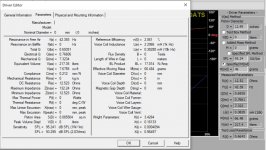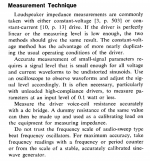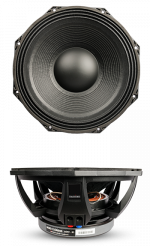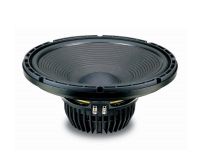Does anyone know the dispersion pattern width of a typical tractrix horn? I always see 60x40, 90x60 for biradials and the like...what are the angles for a typical tractrix horn?
Faital make several nice looking tractrix horns, you could check their spec sheets + 3rd party measurements, e.g.
Test Bench: Faital Pro HF108R Compression Driver | audioXpress
GM while I have your attention, what do you think of my low Bl situation? Acoustic elegance has chosen to ignore my complaints. So its not likely I'm getting a return and refund without a fight....i've read that large drivers with stiff surrounds can give inaccurate readings with "low signal"....yet thiele specs are meant to be low signal....my DAts v3 is supposedly of higher signal strength than the previous versions.... 75% TM on all my drivers....
How do you feel about this? Should I ditch these drivers?
When I look at the BL specs for competing midbasses....like the 15pr400, my low BL readings still compete.
Efficiency and Sensitivity never seem to come near spec either according to the dats, reading some 5db low sensitivity and 50% of efficiency.
I should try taking a 1watt 1meter measurement
How do you feel about this? Should I ditch these drivers?
When I look at the BL specs for competing midbasses....like the 15pr400, my low BL readings still compete.
Efficiency and Sensitivity never seem to come near spec either according to the dats, reading some 5db low sensitivity and 50% of efficiency.
I should try taking a 1watt 1meter measurement
Last edited:
After sitting, the woofer tightened up, signifying that it is not broken in but I don't know how this effects BL it may throw the DATS formula off. I'll give it the benefit of the doubt for the moment, but if it never squares off, I'll likely replace these drivers with another brand. I used specified mmd for these calculations.
Attachments
Camplo,Efficiency and Sensitivity never seem to come near spec either according to the dats, reading some 5db low sensitivity and 50% of efficiency.
I should try taking a 1watt 1meter measurement
The "5dB low" DATS sensitivity you posted references 2.83v (1 watt into 8ohms) so automatically reads -3dB less for a "16 ohm" driver, which would require 4v for 1watt.
Adjusted for that, the sensitivity would be -2.27 dB, rather than -5dB less than the "8 ohm" (6.6 Re) version.
Yes, you should do a 1watt 1meter measurement (preferably outdoors) using 4v and expect 96+ dB in the upper frequency range to sound quite loud.
Art
Attachments
Yes, you should do a 1watt 1meter measurement (preferably outdoors) using 4v and expect 96+ dB in the upper frequency range to sound quite loud.
Art
Then maybe the Qts will come down too?
After sitting, the woofer tightened up, signifying that it is not broken in but I don't know how this effects BL it may throw the DATS formula off. I'll give it the benefit of the doubt for the moment, but if it never squares off, I'll likely replace these drivers with another brand. I used specified mmd for these calculations.
Again, per this: Thiele Small parameters equations - How each one affects the others
BL is BL, so calculating reference efficiency n0 yields the same 2.061% as DATs: n0 = (9.7822 * 10-10 * Vas * Fs^3) / Qes
Increasing BL, Cms or Fs will reduce Qes and Qms.
Increasing Re will result in increasing Qes. This can be done by adding a series resistor, but this will also affect the efficiency of the driver in a negative way.
A higher impedance peak at resonance will translate in a higher Qms.
Ergo, as a driver breaks in, Fs drops, Vas increases in complementary ways such that Qes, Qms, Qts remains 'close enough' the same; ipso facto, efficiency n0 stays 'close enough' the same and why [the better?] manufacturers [use to?] measure it as the only driver spec other than Fs [back only when it was the spec used as a main selling point] for quality assurance QA requirements.
Then maybe the Qts will come down too?
Yes. Measure at levels higher than "small signal" and your Qts values will change.
Some Morel drivers are measured at two levels - small signal and 1 volt.
The 1V numbers (if you saw them in isolation) would indicate a more powerful motor / magnet.
0.44 -vs- 0.36 (Qts)
50.5 -vs- 42.5 (Fs)
8.2 -- vs- 11.8 (VAS)
Roughly a 20% difference.
Higher levels can get a ~35% difference.
TSP are scalar - queries
This is probably why SB Acoustics posts specs measured at 1 volt. It's a crafty way to bump up their specs.
Last edited:
Camplo,
The "5dB low" DATS sensitivity you posted references 2.83v (1 watt into 8ohms) so automatically reads -3dB less for a "16 ohm" driver, which would require 4v for 1watt.
Adjusted for that, the sensitivity would be -2.27 dB, rather than -5dB less than the "8 ohm" (6.6 Re) version.
Yes, you should do a 1watt 1meter measurement (preferably outdoors) using 4v and expect 96+ dB in the upper frequency range to sound quite loud.
Art
Ok ok ok I see it now....sooooo....I could say that BL is also being skewed because of this 2.83V issue or no?
I just grew a brain and hooked up the multimeter to the output of the dats to check voltage....as it sweeps I get a peak at 2.5v it could be due to many things but this thing definitely ain't hitting 4v....the predicted 1w/1m is only off a few db.
So that still leaves BL....No idea what Formula this thing (DATS) use's to calculate BL....
Some people are saying I am obsessing over something that is trivial. Others are saying I paid too much money to be shy'd on BL and efficiency....which one is it...I'm looking for objective answers not maybe maybe's....The thiele small parameters are meant to be that...small voltage.
So when I check that 18h+ I get 21tm and 2.19 for efficiency....
According to GM above, efficiency is a great way to judge a driver because break in does not cause a huge swing in the resulting figure.
So both 15m and 18h+ is reading at 50% efficiency vs rated spec
So when I look at the faital pro pr400 and fh500 there efficiency numbers are in the same arena as what I am getting....so basically its not so much that Acoustic Elegance has sent me a crap speaker....its that their drivers have bloated specs to begin with, regardless with how good or not good they are.....their drivers specs are of super man nature when there is no need because the real number they pull are still good...
A good driver....not getting what you paid for specs wise.
At least now that I understand more concretely how I am getting screwed I can feel ok with moving on....Qts being off with the 15m is my biggest loss.... I can adjust Qts with a resistor but it will further effect efficiency in a negative way....So this is also the way I have lost out on this investment into Acoustic Elegance. I could go to Loudspeaker Data base and search for woofers with qts that match my needs.
Does anyone have an idea of a better woofer to reach 0.5 qts in my 231l cabinet?
The parameters can vary quite a lot with applied voltage so to make any comparison the voltages need to be the same as the manufacturers conditions.
This is from Small's original paper
http://diyaudioprojects.com/Technical/Papers/Direct-Radiator-Loudspeaker-System-Analysis.pdf
This is from Small's original paper
http://diyaudioprojects.com/Technical/Papers/Direct-Radiator-Loudspeaker-System-Analysis.pdf
Attachments
Dear all,
Seeking opinions on whether either of these 15" woofers be viable candidates that meet the high spl, low distortion (extended bass response) requirement here?....
18 Sound 15NLW9500-8
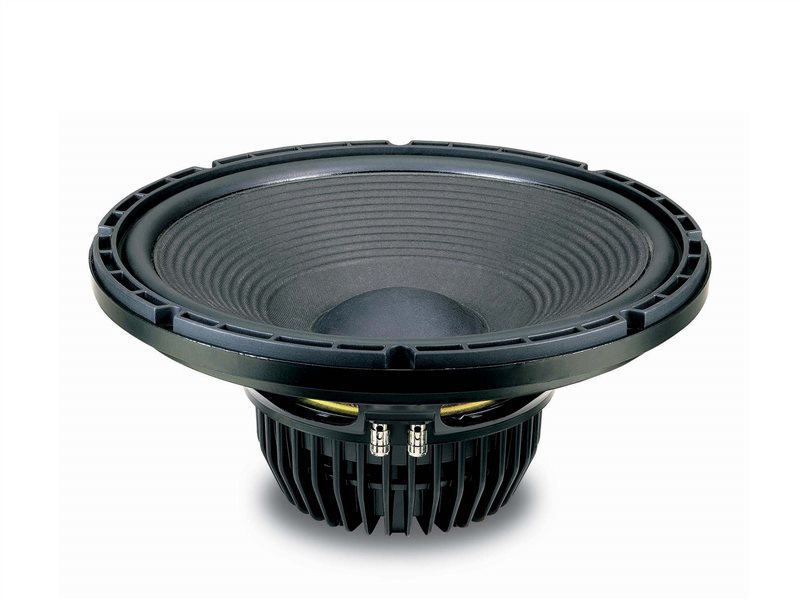
or SB Audience NERO-15SW800
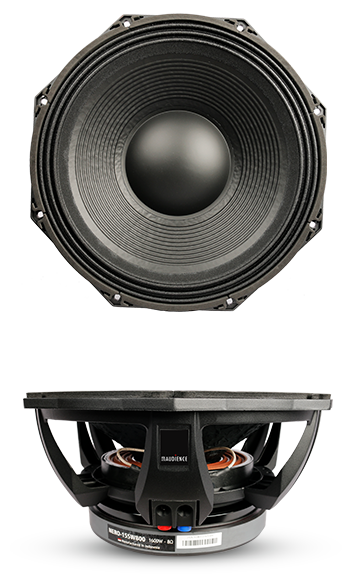
Seeking opinions on whether either of these 15" woofers be viable candidates that meet the high spl, low distortion (extended bass response) requirement here?....
18 Sound 15NLW9500-8
or SB Audience NERO-15SW800
Attachments
At least now that I understand more concretely how I am getting screwed I can feel ok with moving on....Qts being off with the 15m is my biggest loss.... I can adjust Qts with a resistor but it will further effect efficiency in a negative way....So this is also the way I have lost out on this investment into Acoustic Elegance. I could go to Loudspeaker Data base and search for woofers with qts that match my needs.
Hi Camplo
Since you want to lower the Qts you can't just take a resistor out of your parts bin because you would need a negative resistor and those don't come in the usual form of a component with two leads. It has to be synthesized using current feedback from the amp's output. The active PSI studio monitors use something like that. Another method that gives the same response without using current feedback is the use of EQ. If the fc is correct and only the Qtc is wrong you can get the desired response with a parametric EQ. If both the fc and Qtc have to be corrected you can use a biquadratic filter like the Linkwitz transform for instance.
Mazza:
I have four of these Eighteensound woofers. So far I have only listened to them as a short informal test right after delivery. The manufacturer does indeed recommend them for studio monitor use. But he does also recommend to use then only up to 500 Hz. With a large horn they could therefore be used for a two-way system. Maybe they even work nicely slightly higher than 500 Hz. When I find the time in the next few weeks I will mount them in my existing two-ways to see how they perform with a crossover frequency of 650 Hz.
regards
Charles
Last edited:
Thank you Charles!
I would be aiming for an 800hz crossover. I'd be grateful to see some off axis sweeps if possible please.
I would be aiming for an 800hz crossover. I'd be grateful to see some off axis sweeps if possible please.
The 9300 version I own is good to 1200hz where it starts to beam.
I would go for a driver with a demodulation ring if you're going to be pushing them hard in a two way application.
I would go for a driver with a demodulation ring if you're going to be pushing them hard in a two way application.
I guess the 9500 behaves about the same regarding beaming. It doesn't extend as high but will go lower than the 9300.
Regards
Charles
Regards
Charles
Dear all,
Seeking opinions on whether either of these 15" woofers be viable candidates that meet the high spl, low distortion (extended bass response) requirement here?....
18 Sound 15NLW9500-8
or SB Audience NERO-15SW800
Both are typical LF woofers and personally I would use another driver for such a high XO point.
If I had to choose, based on the data in the spec sheets, I'd take the 18Sound because of the rising response with frequency and the impedance staying more or less flat > 1000 Hz (with a small step at 500 Hz, where you'd ideally cross this driver).
Le is considerably lower as well.
Aperiodic or try Hartley Boffle type enclosure
Yes. Or this -
Hartley Speakers and 'The Boffle' | The Audio Standard
I think aperiodic is an acceptable compromise to a transmission line. I have diy'd both. I like both. Aperiodic take some stress off the box compared to closed. Small loss at very low frequencies.
I did John Cockroft style transmission lines with Hartley 24" drivers. Few decades ago. No pics. Was kind of crazy, but they worked well. Looked sort of like this, with the drive at the bottom facing the floor -
Nick's Tubular TL
Some diy t-lines -
Transmission Line Speakers
Any t-line gets big.
Haven't tried the Boffle yet.
Greatly enjoying your thread.
Yes. Or this -
Hartley Speakers and 'The Boffle' | The Audio Standard
I think aperiodic is an acceptable compromise to a transmission line. I have diy'd both. I like both. Aperiodic take some stress off the box compared to closed. Small loss at very low frequencies.
I did John Cockroft style transmission lines with Hartley 24" drivers. Few decades ago. No pics. Was kind of crazy, but they worked well. Looked sort of like this, with the drive at the bottom facing the floor -
Nick's Tubular TL
Some diy t-lines -
Transmission Line Speakers
Any t-line gets big.
Haven't tried the Boffle yet.
Greatly enjoying your thread.
btw, the 15FH500 16 ohms woofer has a QTS of 0.45 which is very close to what camplo requested. The mmd is only 67.5g. In the impedance range you have to a ware that QTS goes down if the model is 8 or 4 ohms. I own a pair of the 16 ohms version and can recommend it.
Remarkable Sub SI HS24mkII
I use the Stereo Integrity HS24mkII's. 10 cu ft sealed boxes. Heavy, 300#, but a small box for this level of sub.
Please forgive me if I am being redundant. I'm still catching up. I'm 9 months behind on this board.
I can totally see on paper how a transmission line has the best bass according to many accounts on this board. I'm currently googling brand name studio monitor subwoofers impedance curves but haven't found much. I don't know what models of subwoofer the crowd here considers to be "remarkable". Name some, or drop some "impressive" subwoofer impedance charts.
I use the Stereo Integrity HS24mkII's. 10 cu ft sealed boxes. Heavy, 300#, but a small box for this level of sub.
Please forgive me if I am being redundant. I'm still catching up. I'm 9 months behind on this board.
Has anyone ever actually read the page on transmission lines on wiki? I don't know if to trust it or disregard. Theres some different philosophy on there that I've never read anywhere else. Thank God for GM because there are so many people with opinions on what a Transmission Line is or could be or should be, and non of these people have ever built a damn TL, or if they did, they've built or heard 1 or 2 out a very large amount of possible and claimed successful configurations, and then even the people with a wealth of experience disagree, so I think it turns into a personal, or personality type type choice and I I like GM's style so...boom. My 3d iteration of GM's design turned out pretty good I'd say, its a little beyond some's perception but given my design goals and the anticipated performance of anything that resembles what GM's original design intends, I'll be a happy camper. My design ended up being ~16" over but I also modified the design by exiting the taper all the way to terminus and only a few inches before terminus does the line reach the lowest CSA that originally occupied the last 10" of the design. Still chippin at it, but I think its turning out well.
Never looked at wiki's description and don't care. IMO the general rules for T-lines are questionable.
A true transmission line has no reflections; no standing waves. A true transmission line is not determined by its length; within reason. A true transmission line matches impedance of source to destination. A true t-line is like an aperiodic load with a more open back end. I want to resistively load the back wave till the the reflections back to the driver are minimized. This does not require 1/4 wave calculations, but may require more experimentation with stuffing, density and type, and cross sectional area behind the driver.
None of this involves 1/4 wave calculations. A signal loss of 1/2 is implicit; no back wave output.
Aperiodoc cabs are a reasonable compromise. They are also quite forgiving.
It seems that you may be new to this forum, but not inexperienced as to speaker technology.
Virtually any LF solution can be made to work, taking into account the space/spl requirements etc.
I agree with your last comment.
Oversized, foam filled ports, resulting in a semi-aperiodic cab, can also work very well.
Virtually any LF solution can be made to work, taking into account the space/spl requirements etc.
I agree with your last comment.
Oversized, foam filled ports, resulting in a semi-aperiodic cab, can also work very well.
- Home
- Loudspeakers
- Multi-Way
- Is it possible to cover the whole spectrum, high SPL, low distortion with a 2-way?
